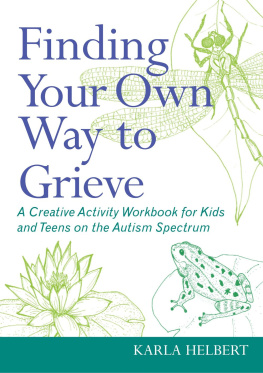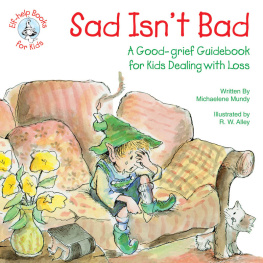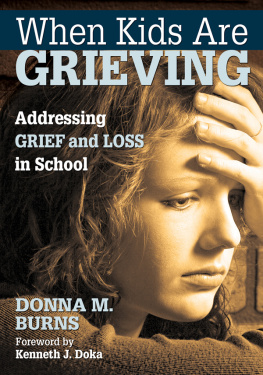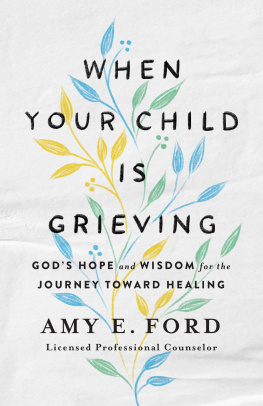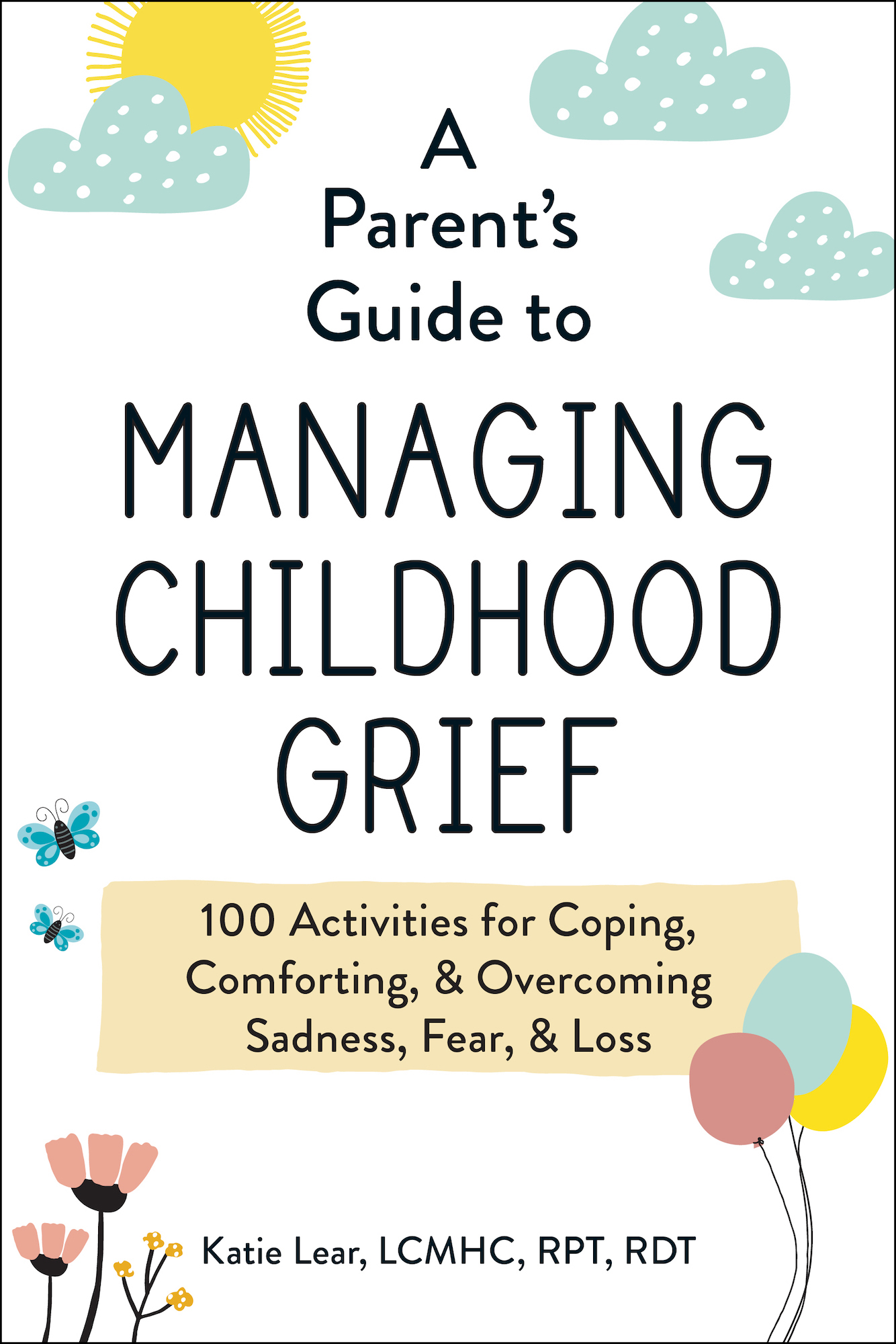Contents
Guide
A Parents Guide to Managing Childhood Grief
100 Activities for Coping, Comforting, & Overcoming Sadness, Fear, & Loss
Katie Lear, LCMHC, RPT, RDT
ACKNOWLEDGMENTS
So many people have contributed to the creation of this book, and Im grateful for all of them. First off, I owe a huge debt of gratitude to Julia Jacques and her team at Adams Media for this opportunity, as well as their support and flexibility along the way. Thank you for making this book a pleasure to write!
Id like to acknowledge the therapists whose research, ideas, and expertise have been foundational to my own understanding of childhood grief and grief therapy, including William Worden, Eliana Gil, Liana Lownstein, Kevin OConnor, Violet Oaklander, Judith Cohen, Anthony Mannarino, and the clinicians at the Dougy Center.
Id also like to thank the Evidence-Based Treatment Dissemination Center and the Kint Institute in New York, as well as Felicia Carroll and the West Coast Institute in California, for their training, which continues to inform my work.
Melanie K. Deal and Brittany Quinzi, both educators, generously lent their expertise on how children can navigate grief in schools. Jordan Carroll provided a valuable second set of eyes when she reviewed the manuscript through the lens of a fellow child therapist. Emma Backer was immensely helpful in guiding this first-time author through the ins and outs of publishing.
Thank you to my parents, Bill and Patty, for the many hours spent sitting on the floor and playing with me, much in the same way that I encourage in this book. Thank you also to Zoe Harrison, our nanny and friend, whose help has made it possible for this new mom to run a therapy practice and raise a child while still having time to write.
Thank you, Steve, for your encouragement and willingness to do more than your fair share of parenting and chores these past few months. And thank you, Elliot, for your sunny personality and generously long naps.
INTRODUCTION
As parents and caregivers, we try to protect our children as much as we can from the difficult parts of life. Sometimes, despite our best efforts, painful experiences find us anyway. Grief and loss are universal experiences. They affect all of us, regardless of our age, race, economics, or gender.
Although we hope that our children wont experience grief until they are older, childhood bereavement is more common than you might expect. Sadly, every year, thousands and thousands of children in the United States lose a parent or a grandparent caregiver. Many families who never imagined theyd find themselves in this situation now have to learn how to grieve alongside their children.
Many cultures are not very comfortable talking about death. Its hard enough for adults to discuss it with each other, let alone figure out how to broach the subject with children. You may wonder how much your young child really understands about death and dying. You might worry that discussing a loved ones death will further upset the child. If you were also affected by the death, it can be even harder to find the right words to comfort a child in the midst of your own grief.
Children learn about the worldeven in difficult timesthrough play. You have probably seen your child repeat play scenarios over and over as they make sense of something new. For bereaved children, play-based activities are opportunities to understand their new normal, express their feelings, and heal. When you participate in play with your child, youre allowing them to feel safe, heard, and loved. In this book, youll find over one hundred activities for kids aged five to eleven to help you and your child reconnect and work through feelings of grief together.
The activities in this book will guide you and your child toward building skills that help people of all ages to process grief. Youll find games, art projects, and hands-on exercises that promote such concepts as:
- Learning about death in an age-appropriate way
- Understanding and embracing a variety of grief responses
- Finding safe outlets for sadness, anger, and fear
- Alleviating feelings of guilt
- Honoring a loved ones memory
- Telling our own stories of grief and loss
- Encouraging hope and dreams for the future
As a childrens therapist, I regularly get to see how resilient children are. Kids cant help but keep growing and changing, even through hard times. With some loving support, they overcome incredibly difficult circumstances. Even if you didnt grow up feeling comfortable talking about death, you can help your children feel safe and supported when they share their own feelings. Giving your child something you didnt receive yourself is a huge gift.
You cant make grief go away or prevent children from hurting when a loved one dies. What you can do is help children learn to live through their grief, remember their loved one who died, and keep moving forward in life. My hope is that, over time, this period of grief becomes one chapter of a much longer story for you and your child.
ALL ABOUT GRIEF
This part of the book provides a foundation for understanding grief and how to talk about it with your child. Even though you dont need any special expertise to use the skills in this book, it will still help to understand grief and its impact on children before you begin. Youll come away from these chapters with some ideas and language you can use to begin conversations with your child.
Whether you are anticipating a death, have recently lost a loved one, or simply want to prepare for the future, youll find information here to guide you. Well talk about different types of grief and the many ways that grief can look and feel. Youll learn how children express grief at different ages so that you can better gauge how your child is coping.
If youre looking for immediate solutions for how to give or get support in the aftermath of a death, there are ideas for you in this part as well. Well look at the ways you can set up supports for your child at school, at home, and in the community. Youll learn how to begin difficult conversations with your child about different kinds of losses and what you can do to help your child feel as safe as possible in the first few days following a death.
Well also discuss how to help involve your child in the mourning process in a way that feels right for your family. If youre wondering whether or not your child should attend a wake, funeral, or memorial service, well weigh the pros and cons.
By the time youve finished this part, youll have some preparation to help your child navigate the shock and chaos of early grief. Youll know what your child needs in order to begin healing, and when it will be most helpful to begin the activities in this book.
CHAPTER 1 WHAT PARENTS NEED TO KNOW ABOUT GRIEF
Grief is a subject many people dont get a chance to talk about before it happens to them. In this chapter, youll learn some basics about grief and mourning that can guide the future work you do with your child. Grief is such a personal experience, and it can show up in so many different ways. You may understandably be concerned about whether the responses you are seeing from your child are typical. Well talk about how a childs grief process is different than an adults, and how different kinds of loss can lead to different types of grief.



